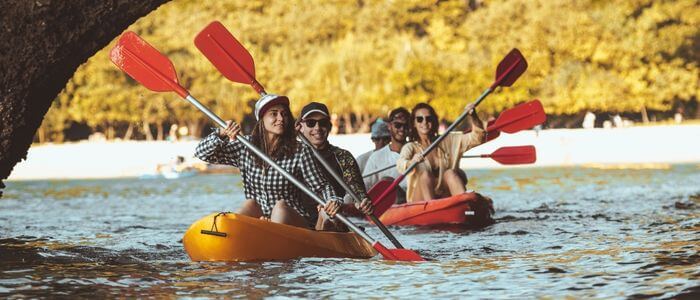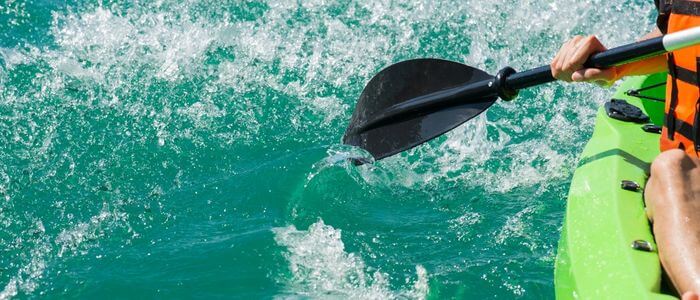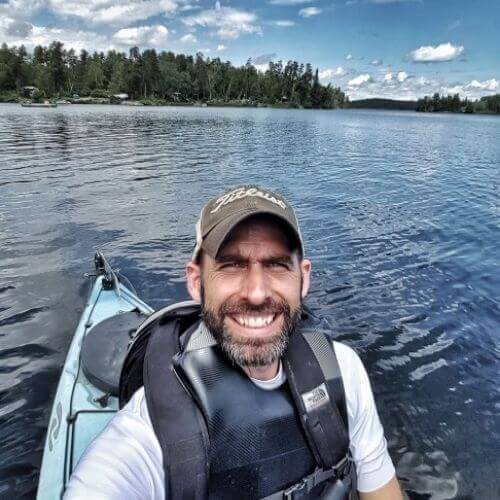
Do you always get wet while kayaking and want to get rid of this problem? Don’t worry; there are some tricks that you can follow and stay dry while kayaking. Here is a complete guide on how to paddle a kayak without getting wet.
First, you will have to choose a kayak that has a flat blade design. This will stop water splashing, and you will stay dry throughout the journey. Secondly, you will have to change how you paddle and use a paddle drip ring that will prevent water from coming to you due to paddle splashing.
You can easily stay dry while kayaking by following the tips mentioned below. So, let’s discuss them in detail and understand the science behind them.

Here are some tips to help you paddle a kayak without getting wet.
If you want to paddle a kayak without getting wet, then you must choose the right kind of kayak. A flat blade design kayak is the best option for this purpose. The flat blade design helps reduce the amount of water that pools on top of the kayak, making it easier to paddle without getting wet.
A flat blade kayak has other advantages over a round or semi-round design. For example, they are more stable and less likely to capsize than a round or semi-round design, which can be dangerous if you get caught in rough seas while paddling.
Round blade kayaks are much more difficult to paddle and have less water stability. Flat blade design kayaks are easier to paddle and have more water stability.
Besides, if you are new to paddling, starting with a flat blade design kayak is best because it is easier for beginners. The best way to choose a flat blade design kayak is by reading reviews online or talking with friends who own one. You can also try demoing different types of kayaks at local stores before buying one for yourself.
One of the most important things is changing your stroke angle. Most people think they need to paddle with their arms straight up in the air, but that’s not true. You’ll want to keep your paddle comfortably angled so that it’s perpendicular to the water and makes contact with the water more often than not—but not too much so that it makes splashing noises and leaves tracks in the water.
This will help prevent water splashing if anything happens and also make it easier for you to maneuver around obstacles or get where you’re going faster than if you weren’t using that angle.
It’s also important to note that other factors are involved in paddling without getting wet: weight distribution and balance are two big. Make sure that as little of your body as possible is touching any part of your kayak; this will help keep it from getting wet or splashed by other boats or people who may be around while you’re on the water.
Paddle drip rings are a great investment for kayakers, who can use them to keep their hands dry while they paddle. They’re also a great way to prevent the water from getting in your boat while paddling.
So, you should also invest in paddle drip rings, but it’s important to know how to use one properly, so you don’t lose your precious paddles.
When buying a paddle drip ring, make sure you are buying the right ring according to the size of your paddle. Only buy things that are adjustable according to your needs and the paddle.
Use a longer paddle shaft if you want to paddle a kayak without getting wet. This can help you stay dry and make it easier for you to move around in your kayak.
A kayak paddle shaft should be long enough to reach the water without getting wet. If your paddle shaft is too short, you must get up on the kayak and bend down while paddling. This can be dangerous because you may fall into the water and hurt yourself or others.
Besides, a longer paddle shaft can help you feel more comfortable and control your kayak. It will help you to get more power out of your stroke, and it can also help you avoid getting wet!
Too short paddles can make it difficult to get a good stroke on the water. They may also make it difficult to paddle steadily without losing control of your boat.
You’ve got to be prepared for the water. Before you even get in the boat, ensure you have all the gear you need, including waterproof clothing, so you don’t get wet from the rain or sleet. Make sure your gear is dry and ready to go before heading out onto the water.
Preparing for the water is a must before heading out in your kayak. You’ll need to wear waterproof gear and have plenty of dry clothes. You might also want to bring a towel in case the boat gets wet and make sure that you have plenty of changeable clothes with you in case your outfit gets wet.
If you’re going on an outing with other people who are also paddling boats, make sure they have their own gear ready to go.
You shouldn’t go out on windy or rainy days if you want to stay dry while paddling. When it’s raining, waves will create spray and splashing. This can make it difficult to paddle if you’re not careful, and it could be disastrous if the spray gets into your kayak or clothes.
The best way to avoid these problems is to wait until the rain stops before heading out on the water. If there are no clouds in the sky, you might still want to bring an umbrella with you.
If you’re paddling in light rain, keep an eye on your surroundings to see where other people are paddling and avoid them if possible. You don’t want anyone to hit you with their paddle.
This is how to paddle a kayak without getting wet.
Choose the Right Kayak: One of the most important things to remember when it comes to staying dry while kayaking is choosing the right boat. You want a kayak that’s light, compact, and easy to carry. A good fit will allow you to move around more easily and easily get in and out of your boat.
Another important factor is how stable your kayak is. If you’re going on long trips, this matters a lot! You don’t want to end up flipping over and getting soaked. Make sure that whatever model you choose has enough room for extra gear so that if you manage to capsize, you’ll have somewhere to put all your stuff before swimming back out into the lake or river.
Wear a Dry Suit: Wearing a Dry Suit is one of the best ways to stay dry while kayaking. Dry suits are made from a special material that allows water to pass upon them but keeps you completely dry inside. It’s incredibly lightweight and easy to wear. You can wear them over your regular suit, or just as an alternative, it’s up to you!
They’re also great for colder climates because they don’t trap heat like a wetsuit. They’ll keep you warm and cozy even when it’s cold outside.
It’s also important to choose the right dry suit for your body type and activity level to stay comfortable and safe while paddling the waters of your choice.
Use a Sea Sock or Cockpit Cover: Sea socks are made from a unique material that’s waterproof and breathable, so they won’t make you feel too hot or cold in the water. On top of that, they don’t absorb much water, so they dry quickly after you get out of the water. They also come in handy if you’re paddling around in rough conditions; they protect your body from getting wet by keeping you dry and warm.
Cockpit covers are a bit different than sea socks. They’re designed to fit over your cockpit seat and keep the moisture in, which means they’ll keep you dryer than if you were wearing nothing.
Paddle Properly: Paddling properly is the most important thing you can do to stay dry while kayaking.
The first step is to use the right paddle for your body. If you’re tall and thin, you’ll want a larger and wider paddle than someone who is short and stocky. A longer, thinner paddle will allow you to reach the water more easily.
Next up is how you hold the paddle. You should position your hands, so they’re in line with each other and perpendicular to the waterline, like in a figure-four position.
So this is how to paddle a kayak without getting wet. But remember, how hard you try, there will still be some water inside your kayak or clothes, but these tricks will help you not to get completely wet while kayaking on your favorite lake or river. One easy way to paddle a kayak without getting wet is to get paddles that are flat.

Hey there kayak lovers! I’m Jay Schwartz, the author here at Kayak Guidance! You know water sports – you know me! My life is all about it. Kayaking, Paddleboarding, Fishing, Snorkeling and so much more. I love to share my passion and knowledge with all of you.

Hey there kayak lovers! I’m Jay Schwartz, the author here at Kayak Guidance! You know water sports – you know me! My life is all about it. Kayaking, Paddleboarding, Fishing, Snorkeling and so much more. I love to share my passion and knowledge with all of you.

Welcome to KayakGuidance.com! If you’re looking to have some fun outdoor water adventures, then you have come to the right place. We help our readers find the best kayaks and water related equipment to help you have the best time of your life whenever you are engaging in water activities.
This site is a participant in the Amazon services LLC associates program, an affiliate advertising program designed to provide a means for sites to earn advertising fees by advertising and linking to Amazon.com.